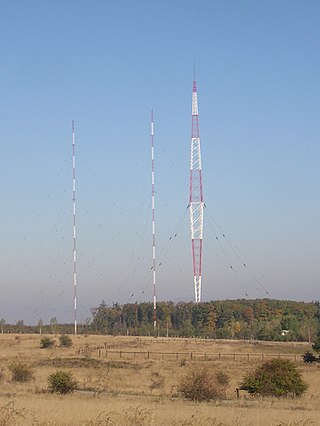Related Research Articles

Telecommunications in Bulgaria include radio, television, fixed and mobile telephones, and the Internet.
Telecommunications in Equatorial Guinea include radio, television, fixed and mobile telephones, and the Internet.
Telecommunications in the Falkland Islands includes radio, television, fixed and mobile telephones, and the Internet.
Telecommunications in Guatemala include radio, television, fixed and mobile telephones, and the Internet.
Telecommunications in Guinea include radio, television, fixed and mobile radio, and the Internet.
Telecommunications in Guinea-Bissau include radio, television, fixed and mobile telephones, and the Internet.
Telecommunication in Honduras started in 1876 when the first telegraph was introduced, continued development with the telephone in 1891, radio in 1928, television in 1959, the Internet in the early 1990s, and cellphones in 1996.
Telecommunications in Jamaica include the fixed and mobile telephone networks, radio, television, and the Internet.
Telecommunications in Kenya include radio, television, fixed and mobile telephones, and the Internet.
Telecommunications in Mozambique include radio, television, fixed and mobile telephones, and the Internet.
Telecommunications in Namibia include radio, television, fixed and mobile telephones, and the Internet.
Telecommunications in Peru include radio and television, fixed and mobile telephones, and the Internet.
Telecommunications in Puerto Rico includes radio, television, fixed and mobile telephones, and the Internet.
Telecommunications in Togo include radio, television, fixed and mobile telephones, and the Internet.
Telecommunications in Trinidad and Tobago include radio, television, fixed and mobile telephones, and the Internet.
Telecommunications in Albania include radio, television, fixed and mobile telephones, and the Internet.
Telecommunications in Belize include radio, television, fixed and mobile telephones, and the Internet.
Telecommunications in Bhutan includes telephones, radio, television, and the Internet.
Telecommunications in Ivory Coast include radio, television, fixed and mobile telephones, and the Internet.
Telecommunications in Costa Rica include radio, television, fixed and mobile telephones, and the Internet.
References
 This article incorporates public domain material from The World Factbook. CIA.
This article incorporates public domain material from The World Factbook. CIA. This article incorporates public domain material from websites or documents of the United States Department of State .
This article incorporates public domain material from websites or documents of the United States Department of State .
- 1 2 3 4 5 6 7 8 9 "Communications", Papua New Guinea, World Fact Book, U.S. Central Intelligence Agency, 4 December 2013. Retrieved 25 December 2013.
- ↑ "Delegation Record for .PG", Internet Assigned Numbers Authority, 9 July 2010. Retrieved 25 December 2013.
- ↑ "Percentage of Individuals using the Internet 2000-2012", International Telecommunication Union (Geneva), June 2013, retrieved 22 June 2013
- 1 2 Calculated using penetration rate and population data from "Countries and Areas Ranked by Population: 2012" Archived 2017-03-29 at the Wayback Machine , Population data, International Programs, U.S. Census Bureau, retrieved 26 June 2013
- ↑ "Fixed (wired)-broadband subscriptions per 100 inhabitants 2012" Archived 2019-07-26 at the Wayback Machine , Dynamic Report, ITU ITC EYE, International Telecommunication Union. Retrieved on 29 June 2013.
- ↑ "Active mobile-broadband subscriptions per 100 inhabitants 2012" Archived 2019-07-26 at the Wayback Machine , Dynamic Report, ITU ITC EYE, International Telecommunication Union. Retrieved on 29 June 2013.
- ↑ "Internet hosts", World Factbook, U.S. Central Intelligence Agency, 2012, accessed 17 June 2013
- ↑ Select Formats Archived 2009-05-13 at the Wayback Machine , Country IP Blocks. Accessed on 2 April 2012. Note: Site is said to be updated daily.
- ↑ Population Archived 2018-10-04 at the Wayback Machine , World Factbook, U.S. Central Intelligence Agency. Retrieved 2 April 2012. Note: Data are mostly for 1 July 2012.
- 1 2 "Papua New Guinea", Country Reports on Human Rights Practices for 2012, Bureau of Democracy, Human Rights and Labor, U.S. Department of State, 22 March 2013. Retrieved 25 December 2013.
